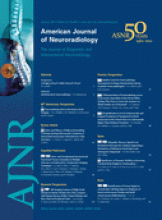Abstract
BACKGROUND AND PURPOSE: The safety of placing multiple overlapped endoluminal flow diverters remains unclear because small eloquent branch arteries theoretically could become occluded by these devices. We placed single and multiple flow diverters over small branch arteries in rabbit aortas to determine the incidence of branch artery occlusion.
MATERIALS AND METHODS: Flow diverters (PED) were placed into 22 female New Zealand white rabbits abdominal aortas to cover ≥1 lumbar artery. Animals were divided into 3 groups (single PED, n = 9; double PED with 2 telescoped/overlapped devices, n = 7; and triple PED, with 3 telescoped/overlapped devices, n = 6) and were followed for 6 or 12 months. DSA was performed at follow-up. Subsequently, the tissue was processed, sectioned, and stained with H&E for histologic evaluation, histomorphometry, and analysis.
RESULTS: All the lumbar arteries covered by devices were clearly patent on angiography. Partial neointima covered the ostia of the branch vessels, but demonstrable patent lumens at the ostia in all cases were present. Neointima hyperplasia was minimal in the single-PED-group animals. The measured neointima was thicker for the double- and triple-PED groups compared with the single-PED group (P < .05). However, in all groups, the mean thickness of the neointima was ≤0.2 mm, and the percentage stenosis of the parent artery was <15% and 18% for 6 and 12 months, respectively. There was no significant inflammatory response in any group.
CONCLUSIONS: Small branch arteries remain patent even when covered by multiple overlapped PED flow-diverter devices.
Abbreviations
- HSD
- Honestly Significant Difference
- IEL
- internal elastic lamina
- PED
- Pipeline Embolic Device
- PO
- Per Os
- © 2012 by American Journal of Neuroradiology












